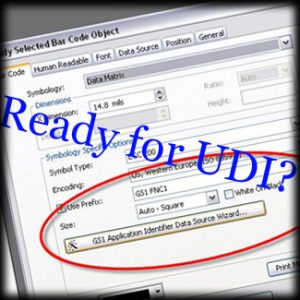What is UDI?
The Food and Drug Administration (FDA) has established a system to adequately identify medical devices through distribution and use. This rule requires the label of these devices to include a unique device identifier (UDI), unless there is some sort of exception. The system basically requires that the label and packaging include a UDI in both text and machine-readable (i.e., barcode) form. In the event that a device is intended to be used more than once, the FDA requires that the UDI be marked directly on the device.
Device labelers must also submit certain information about each device to FDA’s Global Unique Device Identification Database (GUDID).
This device ID system offers a number of benefits; it will work to improve patient safety, encourage technology innovation, and help modernize device surveillance (post-market) as it pertains to pre-market approval or new uses for existing devices .
UDI Compliance
Class I and unclassified devices will have to meet UDI labeling, GUDID data submission and standard date formatting rules by September 24, 2020. The new deadlines do not apply to Class I or unclassified devices that are implantable, life-supporting or life-sustaining.
Approximately 1.4 million records have already been submitted to the FDA’s Global Unique Device Identification Database (GUDID) as of May 1, 2017. However, UDI implementation for higher-risk devices has created some technical and policy challenges for both FDA regulators and registrants, so by extending the UDI labeling timelines for low-risk devices they can address and remedy the challenges before more data is collected.
The FDA classifies medical devices based on the risks associated with the device. Devices are classified into one of three categories—Class I, Class II, and Class III.
Class I devices are deemed to be low risk and subject to minimal regulatory controls. Dental floss, for example, is classified as a Class I device.
Class II devices are higher risk devices requiring more controls in order to provide a reasonable confidence that the device is safe and effective. For example, pregnancy test kits are classified as Class II devices.
Class III devices are largely higher-risk devices subject to a much higher level of regulatory control. Class III devices must go through the FDA for approval before being released to the market. Implantable pacemakers are considered Class III devices.
Benefits of the UDI system
The Unique Device Identification (UDI) System opens up a number of benefits to the healthcare system, consumers, providers, the industry as a whole, and the FDA:
- More accurate reporting; with the ability to analyze reports to identify and resolve issues quickly and effectively.
- Greater opportunity to reduce medical errors caused by misidentification of devices, or to assist with access to detailed information about the device.
- A clear standard that allows these entities to document device use; this applies to EHR (electronic health records), clinical information systems, registries, etc.
- A unique and standardized identifier enables manufacturers, distributors and healthcare facilities to better manage device recalls.
For more information on UDI or if you need guidance preparing for labeling requirements, be sure to contact us.

Recent Comments